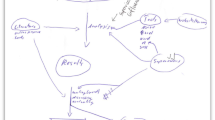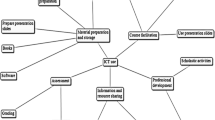Abstract
There is an expectation that new science teachers will be able to effectively use a range of information communication technology (ICT) related resources inthe science classroom in order to enhance student learning. All school systems in Australia are in the process of providing teachers with ICT professional development and infrastructure. This paper outlines a range of initiatives designed to integrate ICT in a compulsory science education unit for students enrolled in a Graduate Diploma in Secondary Education. An action research model based on constructivist principles was used to evaluate the effectiveness of modelling, open-ended co-operative group activities and authentic assessment in enabling students to enhance their ICT skills, knowledge and pedagogical content knowledge in a science education context. Multiple sources of data were generated including a pre and post unit questionnaire that was analysed using Rasch modelling. The questionnaire determined students' perceptions of their preparedness to teach using ICT. The findings of this research suggest that some skills warranted greater attention in the unit, but students' pedagogical knowledge and knowledge and critique of ICT resources were enhanced over the duration of the unit.
Similar content being viewed by others
References
Andrich, D., de Jong, J.H.A.L. & Sheridan, B.E. (1997). Diagnostic opportunities with the Rasch model for ordered response categories. In J. Rost & R. Langeheine (Eds.), Applications of latent trait and latent class models in the social sciences (pp. 59–70). New York, NY: Waxmann.
Andrich, D., Sheridan, B. & Luo, G. (2000). RUMM2010: A Windows interactive program for analysing data with Rasch unidimensional models for measurement. Perth, Western Australia: RUMM Laboratory.
Biotechnology Australia. (2001). Biotechnology Online School Resource. Canberra, Australian Capital Territory: Commonwealth of Australia.
British Educational Communications and Technology Agency. (2003). What research says about using ICT in science. Report to the BECTA ICT Research network. Retrieved from http://www.becta.org.uk/research/ictrn on 15 February.
Cahill, J. & Spence, R. (1999). Heinemann science for Western Australia 2: An outcomes based approach. Post Melbourne, Vic: Reed International.
Connelly, F.M. & Clandinin, D.J. (1988). Teachers as curriculum planners: Narratives of experience. New York, NY: Teachers College Press.
Curriculum Council of WA. (1998). Curriculum Framework for Kindergarten to Year 12 Education in Western Australia. Perth, WA: Curriculum Council of WA.
Dawson, V.M. & Reid, D. (2003, July). Preparing preservice science teachers for ICT rich secondary classrooms. Paper presented at the 34th annual conference of the Australasian Science Education Research Association (ASERA), Melbourne, Victoria.
Dawson, V. & Taylor, P.C. (1998). Establishing open and critical discourses in the science classroom: Reflecting on initial difficulties. Research in Science Education, 28(3), 317–336.
Forster, P.A., Dawson, V.M. & Reid, D. (2005). Preparedness to teach with ICT. Australian Journal of Educational Technology, 21(1), 1–18.
Goodrum, D., Hackling, M. & Trotter, H. (2003). Collaborative Australian Secondary Science Program pilot study. Perth, Western Australia: Edith Cowan University.
Guba, E.G. & Lincoln, Y.S. (1989). Fourth generation evaluation. Newbury Park, California: Sage.
Hackling, M. (2004). Assessment in science. In G. Venville & V. Dawson (Eds.), The art of teaching science (pp. 126–144). Crows Nest, NSW: Allen & Unwin.
Holly, M. (1992). Keeping a personal-professional journal. Geelong, Vic: Deakin University Press.
InfoDev. (2005). Knowledge maps: ICTs in education. Retrieved from http://www.infodev.org/section/programs/mainstreaming_icts/education/knowledgemaps_education on 29 March, 2005.
Kemmis, S. & McTaggart, R. (1988). The action research planner, 3rd ed. Geelong, Vic: Deakin University Press.
Keogh, B. & Naylor, S. (2001). Concept cartoons in science education CD. Science Teachers Association of Queensland.
Leamnson, R. (2001). Does technology present a new way of learning? Educational Technology & Society, 4(1), 75–79.
McGinn, M.K. & Roth, W.-M. (1999). Preparing students for competent scientific practice: Implications of recent research in science and technology. Educational Researcher, 28(3), 14–24.
Pope, M., Hare, D. & Howard, E. (2002). Technology integration: Closing the gap between what preservice teachers are taught to do and what they can do. Journal of Technology and Teacher Education, 10(2), 191–203.
Przywolnik, G. (2001). Integrating appropriate technology in the science classroom. SCIOS, 35(3), 9–11.
Stake, R.E. (2000). Case studies. In N. Denzin & Y. Lincoln (Eds.), Handbook of qualitative research (pp. 435–454). Thousand Oaks, California: Sage.
Taylor, P.C. (1998). Constructivism: Value added. In B. Fraser & K. Tobin (Eds.), Theinternational book of science education (pp. 1111–1123). Dordrecht: Kluwer Academic.
Tytler, R. (2002). Teaching for understanding in science: Student conceptions, research, & changing views of science. Australian Science Teachers' Journal, 48(3), 14–21.
Wang, Y.M. (2002). When technology meets beliefs: Preservice teachers' perception of the teacher's role in the classroom with computers. Journal of Research on Technology in Education, 35(1), 150–161.
Author information
Authors and Affiliations
Corresponding author
Rights and permissions
About this article
Cite this article
Dawson, V., Forster, P. & Reid, D. Information Communication Technology (ICT) integration in a science education unit for preservice science teachers; students' perceptions of their ICT skills, knowledge and pedagogy. Int J Sci Math Educ 4, 345–363 (2006). https://doi.org/10.1007/s10763-005-9003-x
Received:
Accepted:
Published:
Issue Date:
DOI: https://doi.org/10.1007/s10763-005-9003-x




